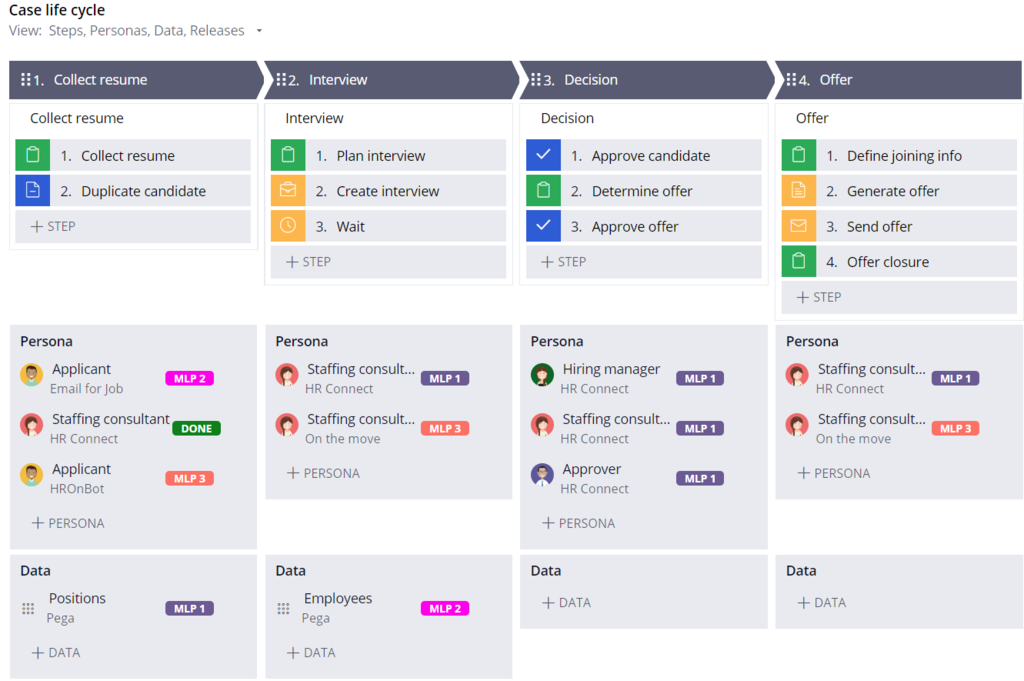
Microjourney prioritization
Minimum Lovable Product
The Pega Express™ delivery approach encourages you to bundle application changes into a software release called a Minimum Lovable Product (MLP). One or more prioritized Microjourneys™ make up each MLP.
A Minimum Lovable Product is different from a minimum viable product, which focuses on achieving something feasible. A Minimum Lovable Product delivers a solution that is not only viable but desired and embraced by end users. An MLP is packaged to quickly deliver business outcomes in a way that delights customers and makes their lives easier.
Prioritize Microjourneys based on your roadmap and document Microjourneys directly in the Pega Platform application or use an estimation tool called the Case Type Backlog. As you define multiple MLP releases, your team can create an application roadmap.
The Case Type Backlog and other tools to support your project are available on the Pega Express Delivery Resources page. (Depending on your browser, you may need to select the resource link, download, rename, and save the Case Type Backlog tool in order to use it.)
Prioritization of your MLP
Each application release begins with the items in your backlog to include in your Minimum Lovable Product (MLP). As you identify subsequent MLPs, you can create a roadmap of future potential releases.
MLPs ensure that you have a technically viable release to deliver in 60-90 days or less by using the Pega Express delivery approach. Three key considerations for prioritizing what to include in an MLP release are:
1. Technical feasibility. Your team must choose an achievable MLP. For example, avoid creating an MLP that requires unreleased integrations. Your technical team can advise you on which Microjourneys have functional dependencies and which can begin immediately.
2. High business value. Select an MLP that delivers high value and progresses towards meeting the client organization's strategic business outcomes. The Product Owner (a person who makes decisions on behalf of the business) plays a vital role in shaping the initial and subsequent MLP priorities.
3. Timeframe. Your team must prioritize MLPs that are deliverable in 60-90 days. Smaller MLP releases improve the chances that you succeed at Go-Live. Smaller, more frequent releases show value, and you can gather feedback to improve further iterations. Your technical team can advise you on the effort required and the complexity of each Microjourney.
Check your knowledge with the following interaction.
MLP in App Studio
Pega provides two options to capture the Microjourneys that make up your MLP. You can document a Microjourney directly in Pega 8.5 and above, or you can use the Case Type Backlog estimation tool. This first image shows how to capture MLPs directly in Pega Platform by using App Studio. In App Studio, you can flag which MLP release each piece of functionality is to be delivered by.
MLP in the Case Type Backlog tool
If you use the Case Type Backlog tool, you can flag which MLP release targets what Microjourneys by using the Work Backlog tab. You can then populate the Release column (column Q) as MLP1 or MLP2 or future as required. See the following illustration for an example:
You can download the Case Type Backlog tool from the Pega Express Delivery Resources page.
Check your knowledge with the following interaction.
This Topic is available in the following Module:
If you are having problems with your training, please review the Pega Academy Support FAQs.
Want to help us improve this content?

